 1960 Ratings (5.0)
1960 Ratings (5.0)
Transitioning from Non-IT to IT jobs and determination to restart a career after a gap requires a great deal of courage, and Besant Technologies applauds this decision wholeheartedly. Besant Technologies presents a Training CUM Internship Program for Non-IT & Career GAP Candidates to assist aspirants looking for IT Jobs After Career GAP.
This 6-month Internship Programme will include 10+ live projects and hands-on training. Manual testing, Selenium with Java, Selenium with Python, SQL, AWS, AZURE, DevOps (Jenkins, GIT, Maven), Front End (HTML5, CSS3, JavaScript, BootStrap), BackEnd (PHP, JAVA,.Net, Node.Js), Framework (Reactjs, Angularjs), DataBase, Cloud, Testing will be covered in depth. The participants will be awarded Intern Certificate from Besant Technologies on successful completion.
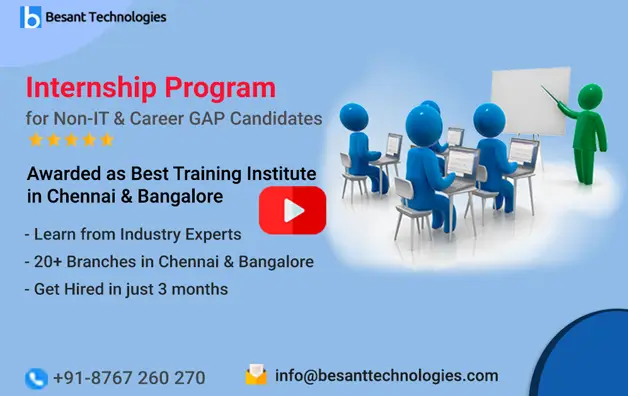
Have Queries? Ask our Experts
The training cum Internship Program is presented by Besant Technologies, which is dedicated to providing individuals with high-quality training to switch from Non-IT to IT Jobs and confirm the chances of getting hired after a career break. The program is structured so that students are immediately connected to industry professionals and will maintain that connection through the end of their program.
The training will be divided into two programs, Program 1 and Program 2, in which the enrolled candidates will learn Manual Testing, Selenium with Java, Selenium with Python, SQL, AWS, AZURE, DevOps, Jenkins, GIT, Maven, HTML5, CSS3, JavaScript, BootStrap, PHP, JAVA,.Net, Node.Js, Framework, Reactjs, Angularjs, DataBase, Cloud, Testing.
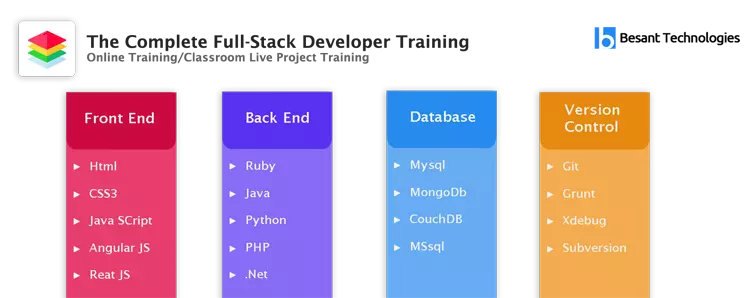
This Training CUM Internship Program at Besant Technologies is open to all fresher’s, graduates, postgraduates, working professionals, technical, non-technical, individuals looking to leave non-IT jobs, engineering graduates, individuals with non-tech roles, non-technical skills, and people looking for IT jobs after a long gap. All an aspirant needs is a desire to learn.
The internship does not have any prerequisites. However, experience in a tech company, coding skills, technical skills, knowledge of the tech industry, and staying up to date on IT jobs are all advantages.
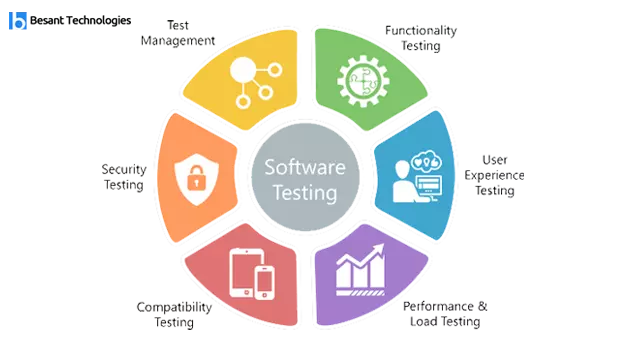
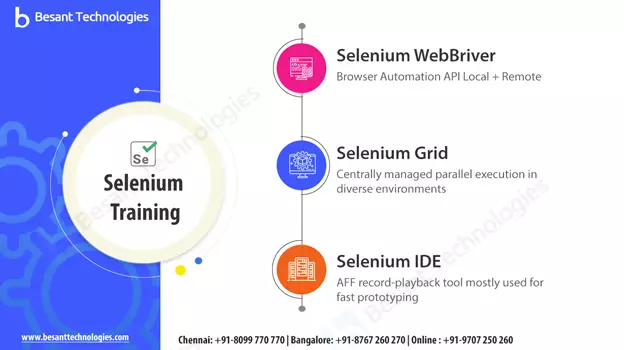
Get upto 30%* Discount in all courses. Limited Offer. T&c Apply.
Register nowTake the first step in your learning journey. Get hands-on experience and be a master. Buy 3 course @24,999/-
Learn moreBesant Technologies provides flexible timings to all our students. If this schedule doesn’t match please let us know. We will try to arrange appropriate timings based on your flexible timings.
Educate employee's in form of learning programs means in turn the success of your business/organization.
Tune upOur Trainers provide complete freedom to the students, to explore the subject and learn based on real-time examples. Our trainers help the candidates in completing their projects and even prepare them for interview questions and answers. Candidates are free to ask any questions at any time.
400+ Students getting placed every month from startup to top level MNC's with decent package after doing course.
Placement record Get your jobBesant Technologies Certification is Accredited by all major Global Companies around the world. We provide after completion of the theoretical and practical sessions to fresher’s as well as corporate trainees.
Our certification at Besant Technologies is accredited worldwide. It increases the value of your resume and you can attain leading job posts with the help of this certification in leading MNC’s of the world. The certification is only provided after successful completion of our training and practical based projects.
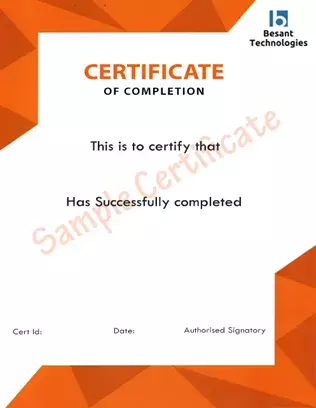
All major global corporations recognize the internship certificate from Besant Technologies. This internship certificate will boost the value of your resume and help you land the IT jobs of your dreams. Upon completing the 6-month training program, Internship participants will receive an Intern Certificate.
Join in a group of three or more on same course we will be delighted to offer you a group discount.
Get DiscountJoin the course, Get your resume modified from experts. Our students are being hired at the leading companies.
Let's goI would like to highlight a few points about my association with Besant Technologies. The faculty members out here are super supportive. They make you understand a concept till they are convinced you have gotten a good grip over it. The second upside is definitely the amount of friendliness in their approach. I and my fellow mates always felt welcome whenever we had doubts. Thirdly, Besant offers extra support to students with a weaker understanding of the field of IT.
s
When I joined Besant Technologies, I didn’t really expect a lot from it, to be extremely honest. But as time went by, I realised I got from Besant Technologies exactly what I wanted- a healthy environment for learning. Cordial teachers and their valuable lectures make understanding things so much easy. I thank Besant for having been so supportive throughout the course.
D




Wondering How to Get IT Jobs after a Long gap? Besant Technologies has developed the best training cum Internship Program. Participants will receive training from industry experts. Upon successfully completing the internship, they will be awarded the Accredited Intern Certificate, which they can highlight in their resume and apply for jobs. Experts with hands-on experience will help you prepare for your next IT job after a career break.
The program is intended for:
You will receive a globally recognized internship completion certificate, which will look great on your resume and, more importantly, will help you get placed in IT jobs.
If you want to restart your career after a break or switch from non-IT to IT jobs, you should get training from Besant Technologies. Besant Technologies aims to provide aspirants like you with the best in-depth knowledge through various projects so that you can fully grasp all concepts and eventually land IT jobs.
Enroll for Classroom, Online, Corporate training.
No 2, Ground floor, 29th Main Road,
Kuvempu Nagar, BTM Layout 2nd Stage,
Bengaluru, Karnataka-560 076
No. 43/2, 2nd Floor, VMR Arcade, Silver Springs Layout,
Munnekollal Varthur Main Road, Marathahalli,
Bengaluru, Karnataka-560 037
No. 179/y, 2nd & 3rd Floor, 12th Main Road
3rd Block Bashyam Circle
Bengaluru, Karnataka-560 010, India
No.229/16, 9th Main Road, 3rd Block,
Jayanagar, Bengaluru, Karnataka-560 041
No.513, CMR Main Rd, HRBR Layout 2nd Block,
HRBR Layout, Kalyan Nagar,
Bengaluru, Karnataka-560 043
Ganga Enclave, No. 7, 3rd Floor, Village,
Doddathoguru,
Neeladri Rd, Karuna Nagar, Electronics City Phase 1,
Electronic City,
Bengaluru, Karnataka-560 100
First Floor, No.54, 5th Main Road,
HAL Old Airport Rd,
Behind Hotel Leela Palace,
HAL 2nd Stage, Kodihalli,
Bengaluru, Karnataka-560008
Plot No. 2799 & 2800, 1st Floor, 27th Main Rd,
1st Sector, HSR Layout,
Bengaluru, Karnataka-560 102
No. 2757/2760 & 2759, 1st Floor,
Kodigehalli Ward No.8, Sahakar Nagar,
Bengaluru, Karnataka-560 092
